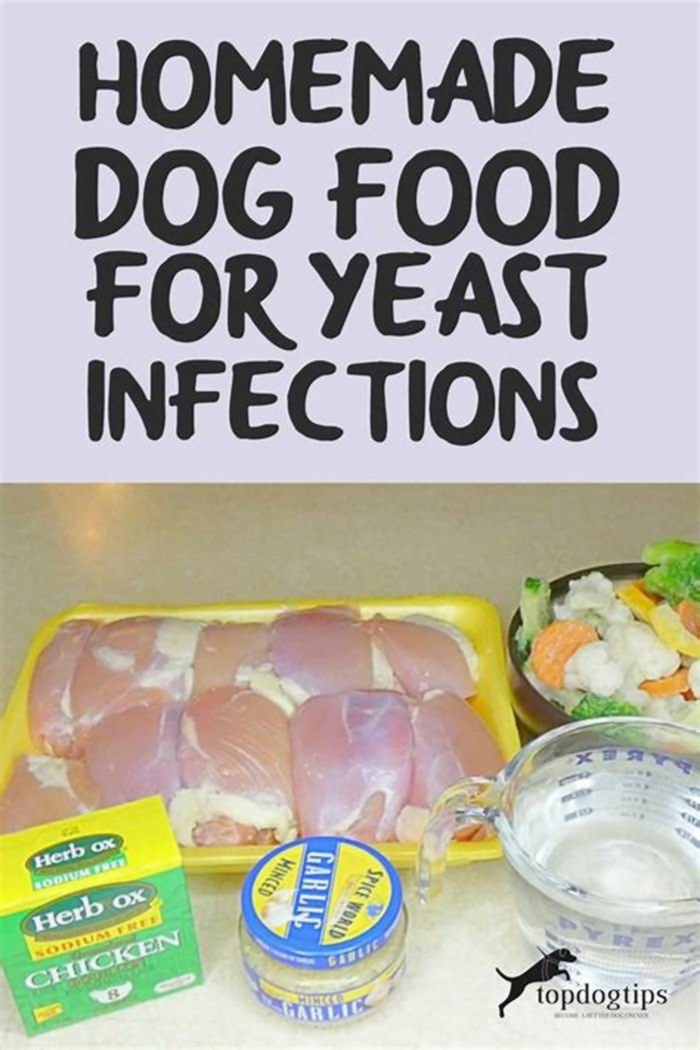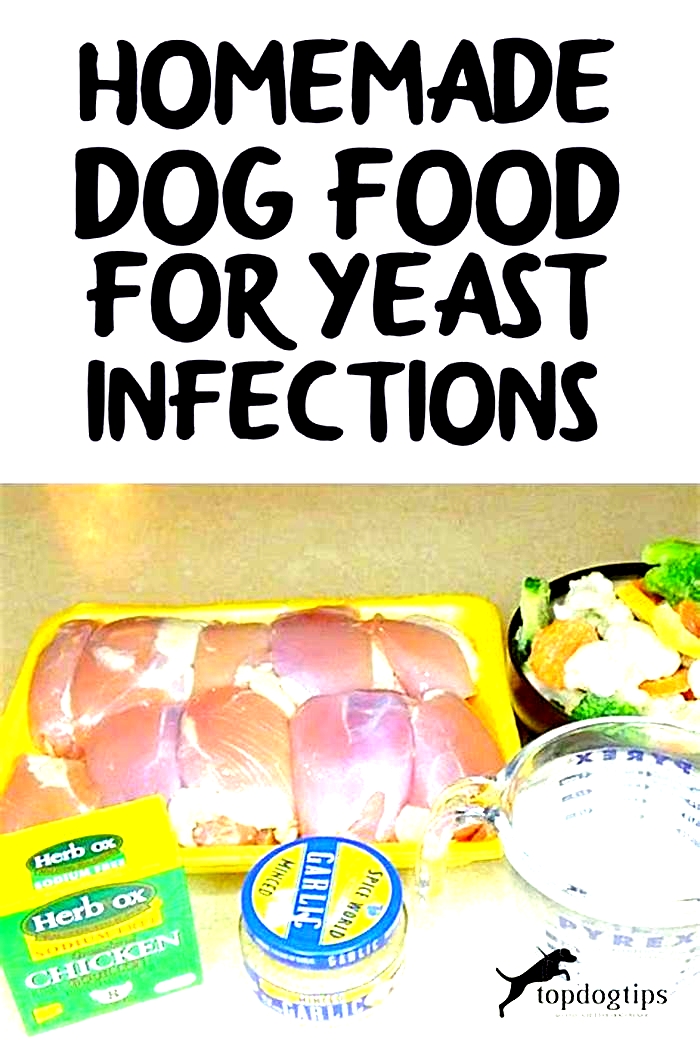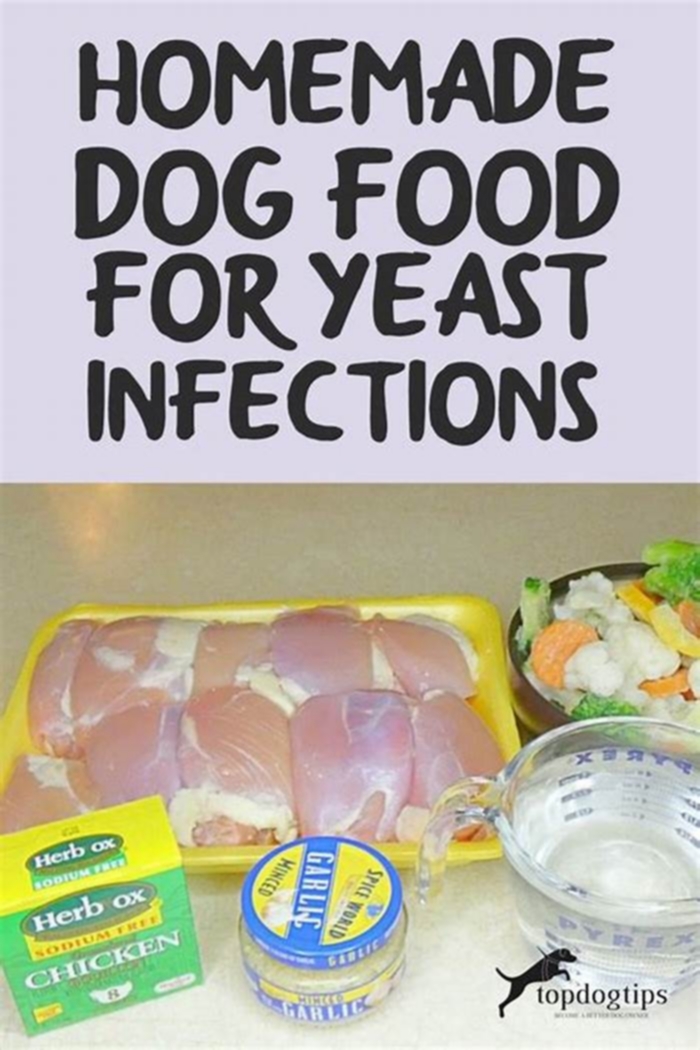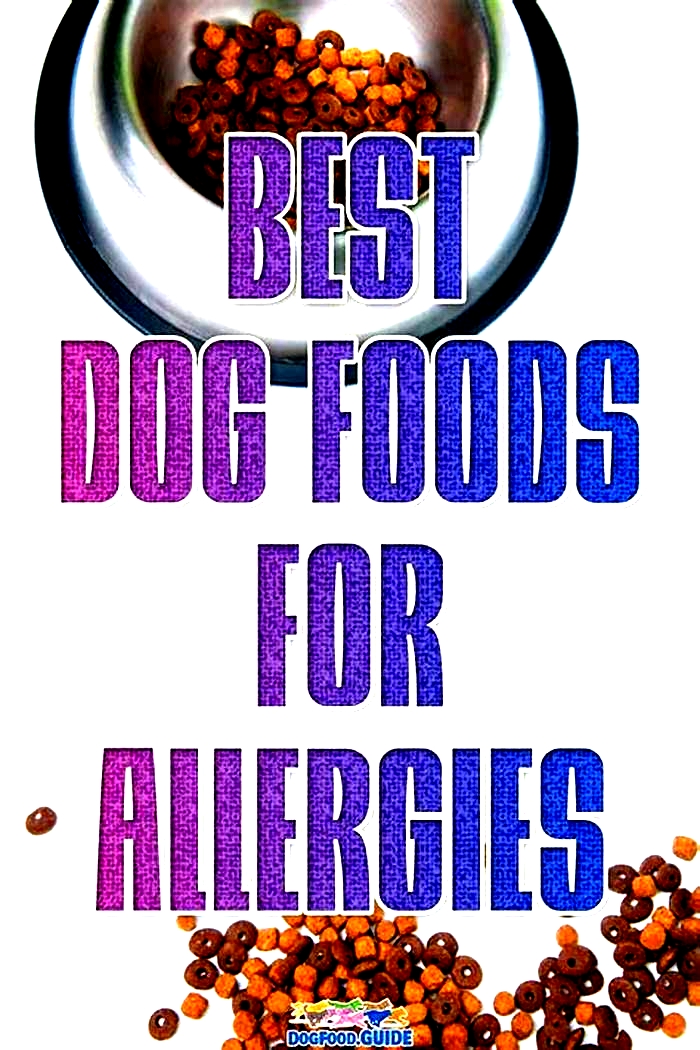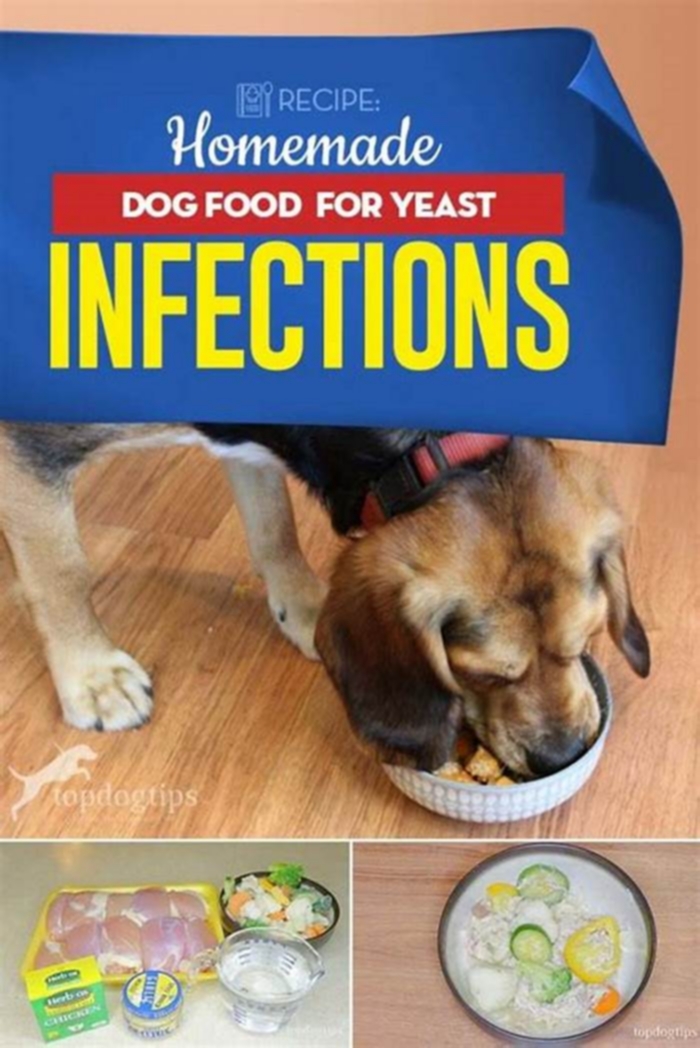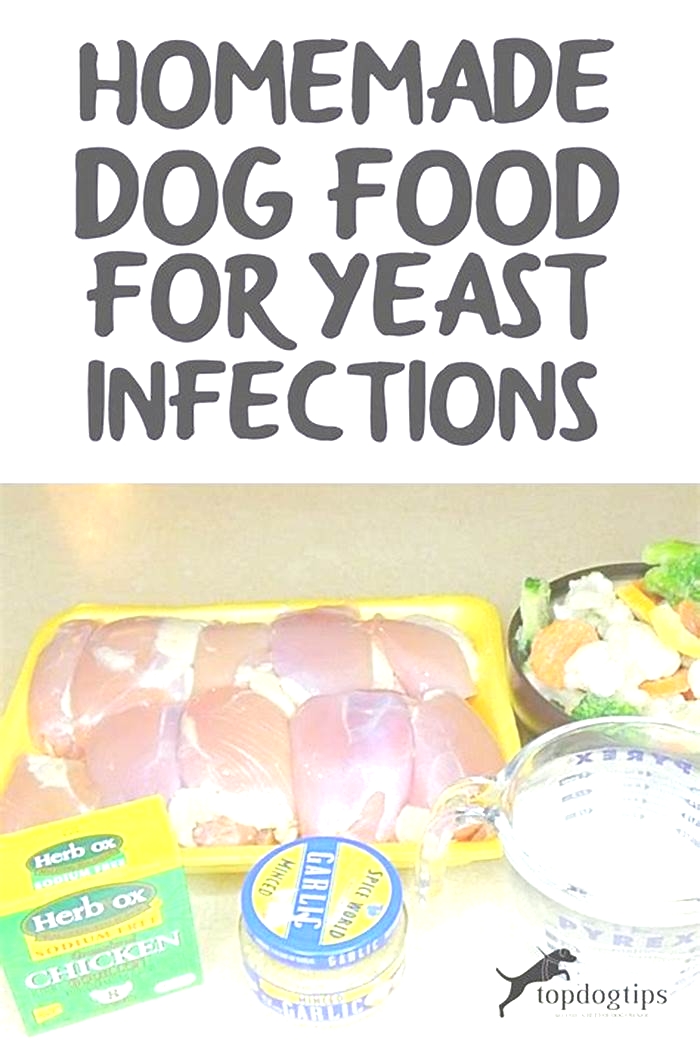homemade dog food yeast starvation
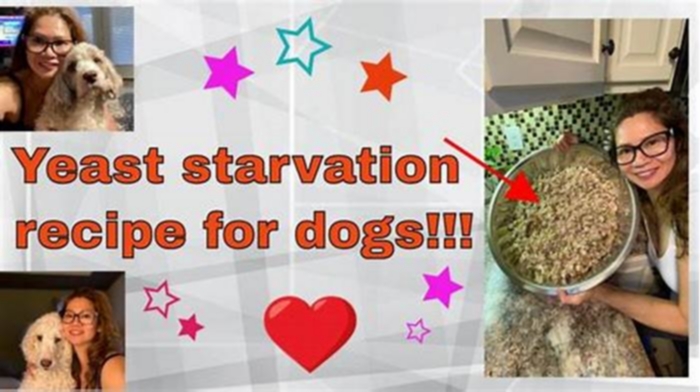
Recipe: Homemade Dog Food for Yeast Infections
Yeast infections are a fairly common skin condition in dogs.
They are typically not something to worry about, but you should seek veterinary care to get the condition cleared up as soon as possible.
What's a yeast infection all about?
This is a skin infection known as yeast dermatitis where 1 particular type of yeast Malassezialives on your dog's skin all the time.
It does not typically cause problems, except for cases of overpopulation.
So today, I came up with this homemade dog food for yeast infections for your Fidos.
This should help clear up skin conditions associated with an overgrowth of yeast.
Let's get cooking, shall we?
 Dog Food for Yeast Infections: Overview
Dog Food for Yeast Infections: Overview
This homemade dog food for yeast infections is also known as a yeast starvation diet. It will help to treat the infection, and then your dog should be gradually returned to his regular diet.
Note: This diet will not provide balanced nutrition for your dog.
If your dog suffers from chronic yeast infections, consult a canine nutritionist about the best yeast starvation to meet his needs.
This recipe may be a good option for your pet, but a canine nutrition expert will likely recommend supplements and/or a multivitamin.
Homemade Dog Food for Yeast Infections Recipe
 Ingredients
Ingredients
- 3 lbs. boneless, skinless chicken thighs
- 2 chicken bouillon cubes
- 2 cloves garlic
- 1 lb. frozen vegetables
Most experts recommend a diet free of grains, potatoes, and yeast if you're trying to make yeast-starvation dog food.
As you can see, this recipe follows those guidelines. However, there is one ingredient that I am often asked about garlic.

Garlic on Dog Food for Yeast Infections
Most pet owners are under the impression that garlic is toxic to dogs.
This is only true for large quantities of garlic.
In moderation,garlic is actually a very beneficial ingredient for canines.
Foods in the genus Allium, like garlic, onions, and leeks were once considered incredibly dangerous for dogs.
But, according to the Journal of Venomous Animals and Toxins including Tropical Diseases:
garlic, on the other hand, is considered to be less toxic and safe for dogs than onion when used in moderation.
Garlic has natural anti-parasitic, anti-fungal, and antibiotic properties.
As I mentioned, this recipe should not be fed for a long period of time.
It will help to treat the infection, and then your dog should be gradually returned to his regular diet.
Directions
Making this homemade dog food for yeast infections is quite simple.
It's a slow cooker recipe, so it's great if you work outside the home and want to prepare homemade food for your pet.
 Step 1: Add the chicken, garlic, bouillon, and water to your slow cooker.
Step 1: Add the chicken, garlic, bouillon, and water to your slow cooker.
Step 2: Cook on low for 6 hours. If you will be out of the house for more than 6 hours, that's okay. Your slow cooker will automatically shut off or switch to a warm' setting after 6 hours.
Step 3: Add the vegetables and cook on low for another 30 minutes. When the homemade dog food for yeast infections is cooled, you can serve it to your dog.
The recommended serving size is about 1/2 cup for every 20 pounds of body weight. You should feed 2 servings per day.
Keep in mind that exceptionally active dogs will require more calories, while less active dogs may not require as many.
You can store leftovers in the refrigerator in an airtight container for up to 6 days.
Do you want Other Options for Dog Food for Yeast Infection? Follow these Rules and Tips
If your dog is prone to yeast infections, then your vet may suggest an anti-yeast diet.
The above dog food recipes are a good starting point, but you can also get creative as long as you know what to include and what to exclude.
Stick to Raw Food
Giving your dog a raw diet is a good choice if he has regular yeast infections. A raw diet is similar to the meat-based diet of your dog's ancestors.
Most importantly for the yeast infection, there will not be processed carbs that will feed the yeast.
Try a Limited-Ingredient Diet
If you don't want to give your pup a raw diet, you can also look for limited-ingredient commercial food.
Because these foods have fewer ingredients, they tend to have fewer low-quality carbs.
Always Minimize Processed Foods
Even if you don't give your dog a raw diet or homemade food, make sure that you stay away from overly-processed foods.
Some ingredients to avoid include excessive starch, high-fructose corn syrup, and corn fillers.
Avoid Natural Sugars
You don't just want to avoid processed sugars and carbs. Dogs with yeast infections should also avoid natural sugars.
Remember that the glucose in the sugar will feed the yeast.
Go Grain-Free
Because carbohydrates fuel yeast infections, dog owners should also strongly consider a grain-free diet.
Prioritize Protein
When creating your pup's new diet, focus on protein. Remember to focus on unprocessed meats.

Dog Food For Yeast Infections: What to Avoid
Common veterinary advice for dogs with yeast infections includes the following list of foods to avoid:
- Bread
- Bacon
- Peanuts
- Pretzels
- Sausage
- Crackers
- Potatoes
- Buttermilk
- Lunch Meat
- Mushrooms
- Gravy or sauce
- Packaged cereal
- Sweet Potatoes or Yams
- Cheese or cottage cheese
- Anything else with grain or sugar
Dog Food For Yeast Infections: What to Include
You can also get creative with a dog food recipe that has the following ingredients, all of which are good for controlling yeast infections in dogs:
If you opt for homemade dog food, always make sure to plan the recipe carefully so your dog gets all the nutrients he needs.
If you haven't made your pup a meal before, start with dog food recipes to get an idea of the proper balance.
What are the Signs of Yeast Infection in Dogs?
If your dog is scratching his ears nonstop and has cracked lips or red, inflamed skin, it could be a sign that it has a yeast infection.
Chewing of the paws is another sign of a yeast infection in dogs, as the yeast can build up between the toes and cause irritation.
Finally, if the red, itchy skin is accompanied by a foul smell, it's very likely that your dog has a yeast infection.
Home remedies may get rid of a yeast infection in dogs, but your veterinarian can also prescribe a topical cream to help treat the condition quickly.
The Role of Pet Foods in Yeast Infections
The environment is not the only factor influencing whether your dog develops a yeast infection; his diet also plays a role.
To survive and grow, yeast needs energy in the form of glucose.
This glucose comes from carbohydrates and starches.
The problem is that many low-quality foods have low-quality carbohydrates, as they are popular, cheap fillers.
These fillers have minimal nutrition but have all the nutrition that yeast needs.
In other words, a low-quality diet can increase the risk of a skin infection or other types of yeast infections.
Feeding your furry friend anti-yeast dog food is a simple way to overcome this challenge. Watching what your dog eats doesn't have to be overwhelming.
While we offer the above recipe, dog owners with less time on their hands can also find commercial options that are right for your dog's diet.
Common Questions About Homemade Yeast Starvation Dog Food
If you still have some doubts about yeast-free dog food, the following information should answer your lingering questions.
What Do You Feed a Dog with a Yeast Infection?
A raw diet is a very popular option for an anti-yeast diet. You can also opt for a partially raw diet.
If you don't have time to make homemade food, consider a commercial homemade diet.
What Food Kills Yeast in Dogs?
Anti-fungal foods for your dog include items with olive leaf, Pau D-Arco, and caprylic acid.
How Do I Reduce My Dog's Yeast Infection?
If your dog is dealing with yeast infections, your vet will likely suggest yeast-free dog food along with topical treatments.
Examples of topical treatments include antifungal creams, shampoos, sprays, and wipes with ketoconazole, miconazole, or chlorhexidine.
Will Yogurt Help My Dog's Yeast Infection?
Yes, yogurt is a good food to include in an anti-yeast diet. This is because of the probiotics, which can fight yeast infections.
For the best results, choose a natural, probiotic yogurt without added sugar.
Dog Food for Yeast Infections: Before You Go
When your dogs are suffering from illnesses or infections, the best way to alleviate pain is to quickly have them assessed by your vet.
But it just doesn't end there.
Your dogs need your support and aftercare, too.
That's when Top Dog Tips steps in.
Hopefully, this dog food recipe for yeast infections can help you get started.
So, if you enjoyed this blog, you might find the following articles helpful, too!
READ NEXT:
WANT TO SHARE THIS

Quick and Easy Homemade Dog Food For Yeast Infections (Foolproof Recipe)
Key Takeaways
- Yeast infections are as common for dogs as for us humans, and can be caused by poor diet or abnormal immune system activity.
- However, you can control your dogs food intake to mitigate the problem by starving the yeast of the nutrients it needs to survive.
- The following recipe of homemade dog food for yeast infections is one of the best dog food recipes Ive tried for that purpose.
Even the toughest, most stoic, and well-trained and active dogs can crumble into an itching mess when a yeast infection rolls around. The good news is that making your own homemade dog food for yeast infections is exceedingly simple. All you need are skinless chicken thighs, frozen vegetables, and the main yeast-killing ingredient, garlic. Cook these in a slow cooker and you have an anti-yeast dog food!
Just like humans, dogs can develop yeast infections. These infections can sometimes become chronic in nature. Whether or not they are, however, yeast infections will make your dogs skin very uncomfortable. Ive only really seen a handful of instances in which a dog was seemingly ignoring their yeast infection, and those dogs were either too old or sickly to care. One of the best ways to help your dog get over a yeast infection is by optimizing their diet. Do this by cutting out the pro-yeast stuff and giving them a healthy helping of natural anti-fungal ingredients. But while diet is important, I always advise dog owners to let the vet take a look at their dog if its the first time theyve gotten a yeast infection. This is always good practice before trying any home remedies, including an anti-yeast diet. Depending on your dogs physiology, sometimes that might not be enough and could be an exercise in futility, or worse even harm your dog. They should be able to tell you for sure if its worth going down that path. Still, more than a few vets have approved my homemade anti-yeast dog food, so Im confident yours will too, but again, it cant hurt to ask.
How Dogs Get Yeast Dermatitis
Yeast infections in dogs are referred to by veterinarians as yeast dermatitis. This condition is caused by an overgrowth of yeast microorganisms.
Just like us, dogs have a type of yeast called Malassezia living on their skin at all times. Although the yeast rarely causes problems, it can end up multiplying at an accelerated rate.
This often happens due to dietary issues, but anything that could decrease or even increase immune system activity can cause an overgrowth of yeast on your dogs skin.
Symptoms of Canine Yeast Dermatitis
One of the first symptoms pet parents may notice in dogs is constant scratching. Does your dog constantly scratch his ears or back? Theres a high chance it could be yeast infection. Itching becomes intense with severe yeast infections and should be monitored. The following are other symptoms you may notice withcanine yeast dermatitis.
- Red, inflamed skin
- Cracked lips
- Chewing at the paws
- Foul odors
The Optimal Homemade Dog Food For Yeast Infections
Before I share the recipe and instructions with you, I want to give you a warning. This dog food does not supply dogs with adequate and balanced nutrition for the long term.
Have you heard of the yeast starvation diet? It essentially just means you have to cut off carbs and sugars in order to restore the balance of yeast in the body. Of course, this also means going with yeast-free dog food, so no bread or bread-adjacent ingredients (kibble is notorious for having a lot of these!).
This literally starves the yeast cells of usable nutrients, making them die off if it is maintained for a long enough period. Hence, the best yeast starvation dog food to give your dog would be one that keeps to the regular diet that your dog eats, which should be full of protein, but without anything that could supply the yeast with energy. This means removing potatoes, yeast, and grains from your dogs diet. These foods have higher sugar content which feeds the yeast and makes them proliferate.
There are a number of dog food recipes out there for a yeast starvation diet, but I find this one to be the easiest and most accessible to make, while still being very effective.But if cooking your own dog food isnt for you, you may also try checking the best fresh dog food delivery service brands today for meals that are customized depending on the needs of your pet.
Ingredients
The ingredients for thishomemade dog foodare simple, and you likely already have them in your home.
- 3 pounds of boneless skinless chicken thighs
- 2 cloves of garlic
- 1 pound of frozen vegetables
You may be surprised to hear I included garlic in this homemade dog food recipe. Like some pet parents, you may think garlic is toxic to dogs. While experts disagree on whether or not thats true, the reality is that plenty of dog owners have been feeding their dogs garlic without ill effects, and its a fairly common ingredient in commercial dog food.
Garlic is only toxic to dogs in large amounts. Small amounts are highly beneficial to them. Garlic is a powerfulnatural antibiotic for dogs,able to perform well as an antifungal, antibacterial, and anti-parasite agent.
Directions
What I really love about this recipe is that you can cook it in a slow cooker. All you have to do is throw all the ingredients, except the veggies, in the slow cooker before work and your dogs dinner will be ready when you get home.
You should cook the ingredients for about six hours on low. Do not add the frozen vegetables until the last 30 minutes. Allow the dog food to cool completely before serving.
How Much Homemade Dog Food Should You Feed For Yeast Infections?
You should feed your dog 1/2 cup of this dog food for every 20 pounds of their body weight. Provide your dog with two servings a day, adjusting for how active they are, whether theyre nursing, and other factors. Consult with your vet if you have concerns.
How to Store This Homemade Recipe Once Cooked
You should store the homemade dog food in an airtight container in the fridge. This recipe will keep for about six days, and it freezes well if you make too much or just want to cook extra.
Tips for Treating Canine Yeast Infections
Chronic yeast infections will likely require an anti-yeast diet. The above recipe is a basic starting point.Yeast infections are sometimes difficult to get rid of if your dog has allergies or a poor immune system[1], so you may need to consult with your vet if the infection does not respond to your efforts.
In addition to the recipe above, I also recommend the following tips.
- Feed your dog a raw diet of mostly meat. Follow my raw dog food recipes for skin allergies.
- Try a limited ingredient diet. The main ingredient should be meat, and the food should contain no grains.
- Minimize processed pet foods always. Make suretreatsand food do not contain high fructose corn syrup or any sugar derivative.
- Prioritize protein in your dogs diet.
Foods to Avoid When Your Dog Has a Yeast Infection
- Crackers
- Bread
- Bacon
- Cheese
- Mushrooms
- Peanuts
- Buttermilk
- Lunch meat
- Fruit
- Peanuts
Frequently Asked Questions
1.What can I feed a dog with a yeast infection?
You should stick to a basic diet that is free of grain and processed foods. The recipe above is a good starting point. Focus on protein and veggies to get rid of the yeast infection.
2.How do I starve my dogs yeast?
Sugar is the biggest food source for yeast. The glucose in foods can feed the yeast and make them thrive and increase. Eliminate all forms of sugar from your dogs diet, including those found in grains and fruits.
3.What ingredient in dog food causes yeast infections?
Sugar can cause yeast to grow in numbers. If your dogs immune systems cannot handle fighting the yeast, infections will occur. While sugar does not cause a yeast infection, it can cause yeast to grow in numbers and will make a yeast infection worse.Yeast in bread and carbohydrates also excel at supplying yeast with energy.

